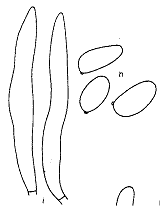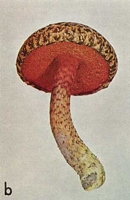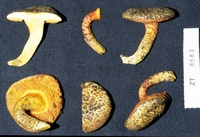|
 Xerocomus macrobbii Xerocomus macrobbii
SynonymsBoletus macrobbii
BiostatusPresent in region - Indigenous. Endemic
Images (click to enlarge)
Caption: FIG. 1. X. mcrobbii: h, spores; i. cystidia. | 
Caption: Fig. 8 - b, Xerocomus mcrobbii (x1) | 
Caption: ZT8683
Owner: E. Horak: © Creative Commons Attribution-Noncommercial 3.0 New Zealand |
Article: McNabb, R.F.R. (1968). The Boletaceae of New Zealand. New Zealand Journal of Botany 6(2): 137-176 (http://www.rsnz.org/publish/abstracts.php).
Description: PILEUS: convex,
2-4.5 cm diam., dry, finely felted to subtomentose when young, becoming coarsely
fibrillose-scaly at maturity, olive at first, cuticle rupturing at maturity
to form adpressed scales and exposing the yellowish brown or reddish context
beneath; cuticle a disorganised cutis; scales composed of septate hyphae 4-7
µm. diam., with brownish contents; margin entire to slightly crenulate-lacerate.
extending beyond pores. HYMENOPHORE: tubes 6-10 mm long. deeply excavated around
apex of stipe, yellow; pores dark red, concolorous with apex of stipe, angular,
0.5-(l) mm diam. STIPE: 3.5-5.5 cm long. more or less equal, 0.5-1 cm diam.,
solid, dry, with adpressed squamules often arranged in irregular rings around
stipe, dark red apically, yellow basally; flesh and basal mycelium bright yellow,
annulus absent.
SPORES: spore print
not obtained; spores deep melleous, broadly elliptical to elliptic-subfusiform,
occasionally obovate. 9.7-14.3 X 4.5-7.2 µm, smooth. HYMENIUM: basidia hyaline,
clavate, 32-49 X 9.8-14 µm, 4-spored; cystidia sparse, scattered, hyaline, thin-walled,
subcylindrical to narrowly ventricose-rostrate, 45-63x4-7 µm. HYMENOPHORAL TRAMA:
bilateral, of the Phylloporus subtype; clamp connections absent. CONTEXT OF
PILEUS: bright yellow, unchanging on exposure to air. TASTE AND SMELL: not distinctive.
Habitat: HABITAT: Gregarious or occasionally caespitose under
Nothofagus.
Notes: Xerocomus mcrobbii has the general appearance of a Boletellus, but may be distinguished
from members of that genus by the short smooth spores and hymenophoral trama
of the Phylloporus subtype. Although the ammonia reaction of fresh pilei is
not known, the short spores (Q=2) indicate that Xerocomus mcrobbii most
probably belongs in sect. Pseudogyrodontes. The fact that it has been
found only under Nothofagus in two widely separated localities suggests
that it is a mycorrhizal species.
Xerocomus mcrobbii may be recognised by the olive pileus, which becomes fibrillose-scaly
at maturity, yellow tubes and deep red pores, and short spores.
|